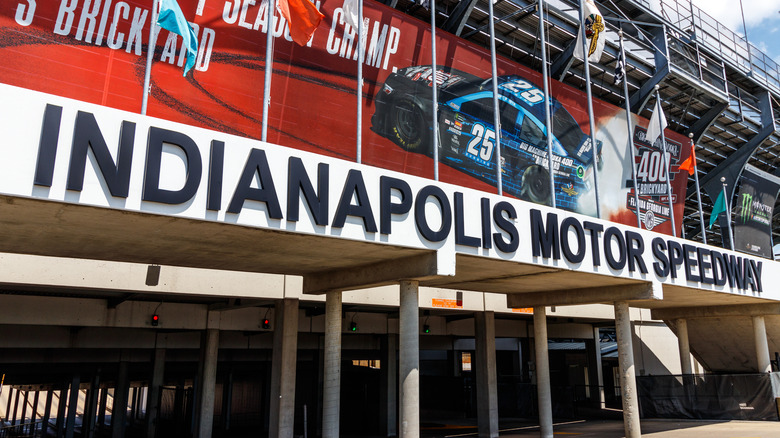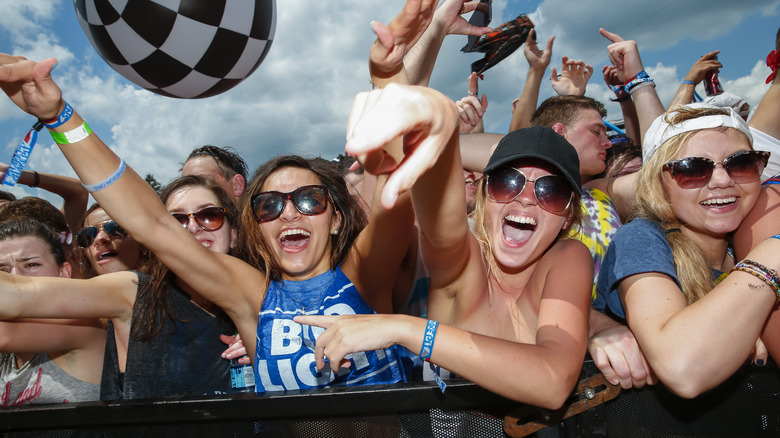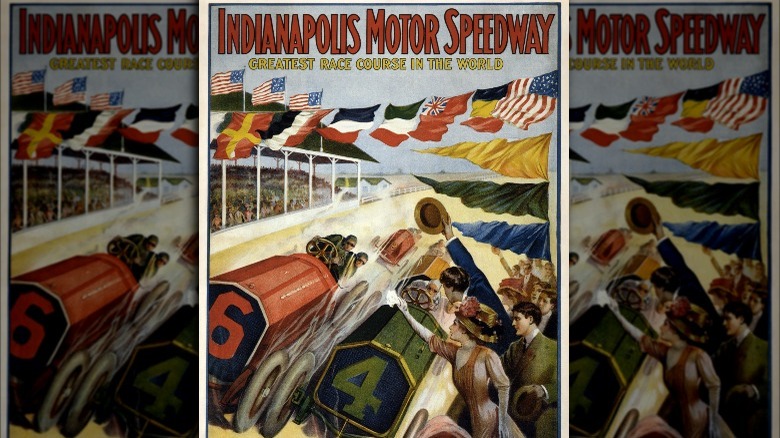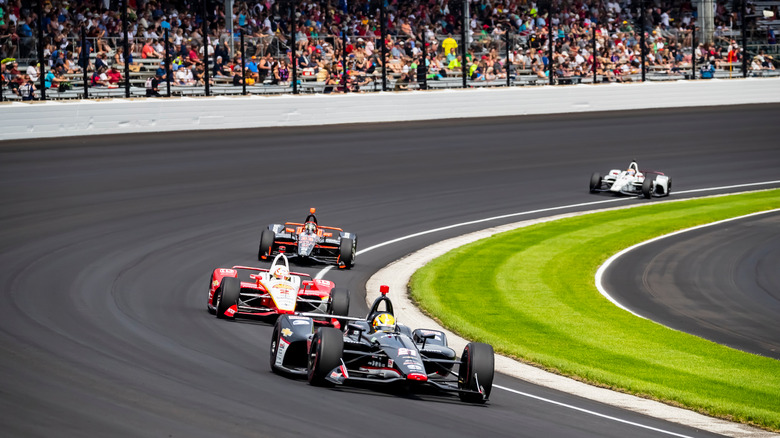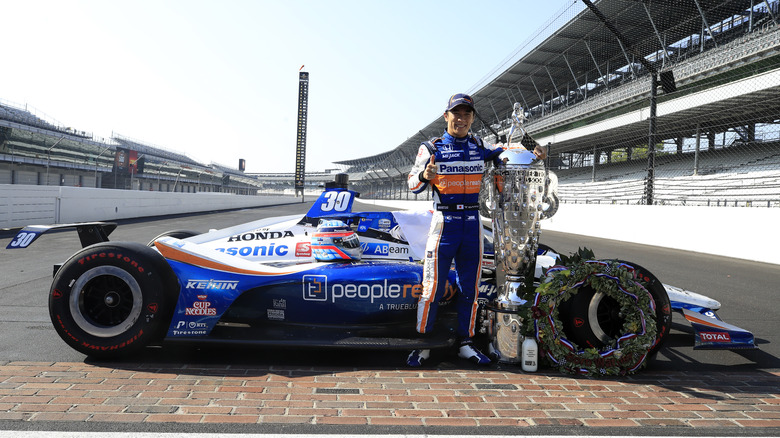Everything You Never Knew About The Indianapolis Motor Speedway
The Indianapolis Motor Speedway (IMS) refers to itself as the "Racing Capital of the World," and it would be hard to disagree. The 112-year-old racetrack annually holds what is arguably the most well known car race in the country, the Indy 500.
The track was originally developed to serve as a testing ground for manufacturers in the burgeoning automobile industry to test speeds on a properly paved roadway, History writes. It can hold up to 400,000 visitors per event, with over 500,000 additional visitors attending pre-race day events (via the Indiana Business Research Center [IRBC]), making it the largest sporting venue in the world, according to Stadium Talk. With 257,325 permanent seats, plus standing room areas, it's just ahead of the Circuit de la Sarthe, which hosts the annual 24 Hours of Le Mans race with a maximum of 234,800 visitors, and could easily seat the entire population of the city of Buffalo, New York (via World Population Review). The IRBC notes that on the day of the Indy 500, IMS attendance makes it the 45th largest city in the United States by population.
Different sections make up the raceway
The track itself is 2.5 miles — it has not changed since it first opened — and the layout is a large oval made up of four turns and straightaways, the IMS writes. The long sections of the oval are 5/8 mile and the shorter end sections are a quick 1/8 mile. Each turn is precisely 9 degrees, 12 minutes and 1/4 mile long, and those dimensions have not changed since the track first opened in 1909.
Since 1934, a maximum of 33 cars are allowed to race on the track at one time, though in the early years of the raceway that fluctuated, with 40 cars starting in the first Indy 500 race in 1911, the site notes. That number is calculated by dividing the size of the track by the "safe" assumed distance between evenly spaced cars, which since 1911 has been determined to be 400 feet for any automobile racetrack.
While the Indy 500 is so named because of the length of the race — 500 miles — the founders settled on that length because they wanted to create one large race that lasted all day, which they thought would draw in the public more than many smaller events, History writes. According to the site, in 1911, founder Carl Fisher and his partners calculated the estimated amount of mileage that it would take for the race to last approximately seven hours lapping around the 2.5 mile track, and their calculations led them to the 500-mile number.
There are a lot of different areas in the venue to watch the race
For the viewing public, there are a lot of different ways to take in the events. The Grandstand seats are split into a number of different sections, including the Paddock areas that run along the front straight with views of the finish line and winner's circle (via Sports Travel Tickets). There are also uncovered Vista sections, Penthouse suites, and the Tower Terrace, which overlooks the pit areas. Pit Passes and Garage Passes let viewers see the action up close and interact with the drivers before the race.
A recent renovation — including over 30 large TV screens throughout the IMS — give views of all the action no matter where people are seated (via Auto Week).
The more "merry" spectators can join the crowd at the track's infield viewing area near Turn Three, called the Snake Pit (via Talk to Tucker), packed full of infamously raucous, enthusiastic, and often drunk fans — most of whom are likely more interested in partying than the actual race. Injuries and police involvement were common in the Snake Pit in the '60s and '70s, reports the Indianapolis Star, though it was considerably tamed by the early '90s. Now scaled down, concerts are held in this section during the race, and it's generally a more controlled environment. However, the heavy partying in this section is so notorious, the IMS created a "Snake Pit Survival Guide" section on their website, and it even has its own Facebook page and Twitter account.
The track and venue have evolved over the years
The speedway was the brainchild of auto enthusiast Carl Fisher, who also created the country's first transcontinental highway, the Lincoln Highway. At the time, CBS News reports, Indianapolis was as big of a center for the automobile industry as Detroit. Because automobiles were still so new, most roads were unpaved, and it was unsafe to drive at top speeds on the dirt tracks (via IMS).
When the raceway was first built in 1909, it had only 12,000 seats, Stadium Talk notes. The initial track was covered in crushed rock and tar (via IMS), but that uneven surface resulted in a number of wrecks and deaths — of both drivers and spectators (via CBS News). It was then paved with bricks and later covered in modern asphalt in 1938, they note on the site, except the front straightaway, which remained mostly brick until 1961. The original brick work remains on the start/finish line, a 36-inch strip referred to as the Yard of Bricks.
The speedway didn't just hold auto races
While the IMS is primarily known for its auto races, it didn't start out that way. According to the website, one of the first events held at the track was a balloon race on June 5, 1909, with motorcycle races and then finally automobile races appearing later that August.
During the '60s, the 500 Festival Open golf tournament, part of the PGA Tour, was played at the IMS. The 18-hole Speedway Golf Course included nine holes inside the oval and nine holes outside near Turn Two. The course has undergone numerous renovations, now called the Brickyard Crossing, but is no longer part of the PGA Tour.
The Indy 500 isn't the only notable car race at the speedway, either. The NASCAR Cup series Brickyard 400 began in 1994, the Indianapolis Star writes, but to date, it is the only other race ever held at the speedway since 1916. However, as of 2021, the Brickyard 400 will be moving to the stadium's FIA Grade 1 road course, no longer running on the classic oval track.
The pandemic affected the race significantly
When the Indy 500 races again on Sunday, May 30, Memorial Day weekend, it will be at 40% capacity with a maximum 135,000 visitors. However, it will still be the largest sporting event in the world since the pandemic began, CBS writes. The 2020 race was postponed until August and only allowed 25% capacity. "This event and this place means so much to everybody we see every day and we hear from every day, whether they are Hoosiers or race fans from around the world. We feel a real responsibility to protect that legacy," president and CEO of Penske Entertainment Corp. Mark Miles told the Associated Press. "It just so happens this will probably be the biggest sporting event of the year."
The purse for the Indy 500 was supposed to be increased in 2020 to over $15 million, Auto Week reports, but was instead cut in half to $7.5 million, Sporting News writes, due to the decreased ticket sales. But to contrast, the winner of the first Indy 500 in 1911, Ray Harroun, finished in six hours and 42 minutes and took home $14,250, which History notes was the largest winner's purse on record at the time.
